The 64 Core Threadripper 3990X CPU Review: In The Midst Of Chaos, AMD Seeks Opportunity
by Dr. Ian Cutress & Gavin Bonshor on February 7, 2020 9:00 AM ESTAMD 3990X Against Prosumer CPUs
The first set of consumers that will be interested in this processor will be those looking to upgrade into the best consumer/prosumer HEDT package available on the market. The $3990 price is a high barrier to entry, but these users and individuals can likely amortize the cost of the processor over its lifetime. To that end, we’ve selected a number of standard HEDT processors that are near in terms of price/core count, as well as putting in the 8-core 5.0 GHz Core i9-9900KS and the 28-core unlocked Xeon W-3175X.
| AMD 3990X Consumer Competition | ||||||
| AnandTech | AMD 3990X |
AMD 3970X |
Intel 3175X |
Intel i9- 10980XE |
AMD 3950X |
Intel 9900KS |
| SEP | $3990 | $1999 | $2999 | $979 | $749 | $513 |
| Cores/T | 64/128 | 32/64 | 28/56 | 18/36 | 16/32 | 8/16 |
| Base Freq | 2900 | 3700 | 3100 | 3000 | 3500 | 5000 |
| Turbo Freq | 4300 | 4500 | 4300 | 4800 | 4700 | 5000 |
| PCIe | 4.0 x64 | 4.0 x64 | 3.0 x48 | 3.0 x48 | 4.0 x24 | 3.0 x16 |
| DDR | 4x 3200 | 4x 3200 | 6x 2666 | 4x 2933 | 2x 3200 | 2x 2666 |
| Max DDR | 512 GB | 512 GB | 512 GB | 256 GB | 128 GB | 128 GB |
| TDP | 280 W | 280 W | 255 W | 165 W | 105 W | 127 W |
The 3990X is beyond anything in price at this level, and even at the highest consumer cost systems, $1000 could be the difference between getting two or three GPUs in a system. There has to be big upsides here moving from the 32 core to the 64 core.
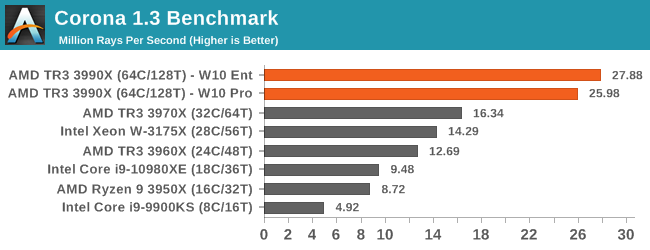
Corona is a classic 'more threads means more performance' benchmark, and while the 3990X doesn't quite get perfect scaling over the 32 core, it is almost there.

The 3990X scores new records in our Blender test, with sizeable speed-ups against the other TR3 hardware.
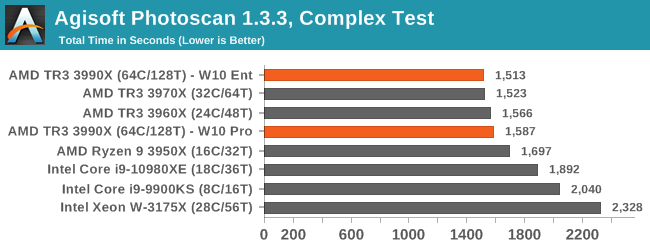
Photoscan is a variable threaded test, and the AMD CPUs still win here, although 24 core up to 64 core all perform within about a minute of each other in this 20 minute test. Intel's best consumer hardware is a few minutes behind.
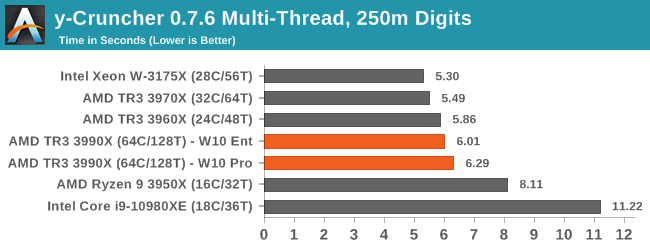
y-cruncher is an AVX-512 accelerated test, and so Intel's 28-core with AVX-512 wins here. Interestingly the 128 cores of the 3990X get in the way here, likely the spawn time of so many threads is adding to the overall time.
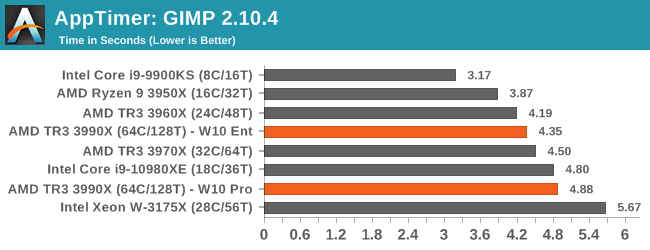
GIMP is a single threaded test designed around opening the program, and Intel's 5.0 GHz chip is the best here. the 64 core hardware isn't that bad here, although the W10 Enterprise data has the better result.
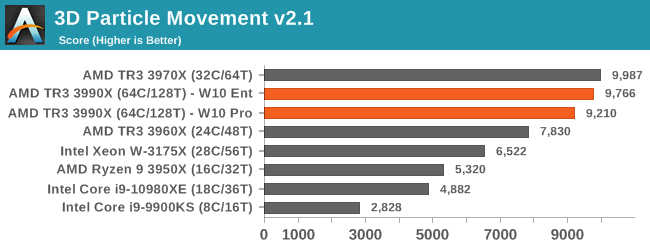
Without any hand tuned code, between 32 core and 64 core workloads on 3DPM, there's actually a slight deficit on 64 core.
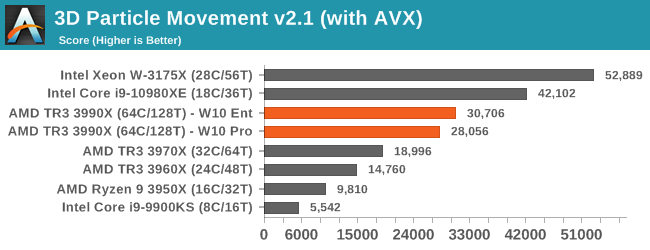
But when we crank in the hand tuned code, the AVX-512 CPUs storm ahead by a considerable margin.
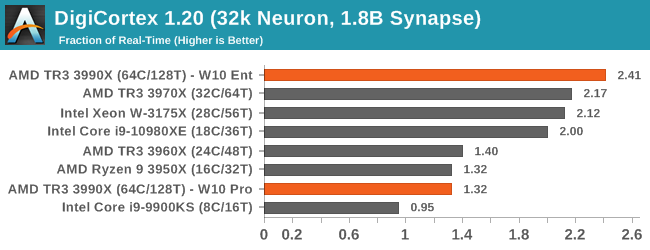
We covered Digicortex on the last page, but it seems that the different thread groups on W10 Pro is holidng the 3990X back a lot. With SMT disabled, we score nearer 3x here.
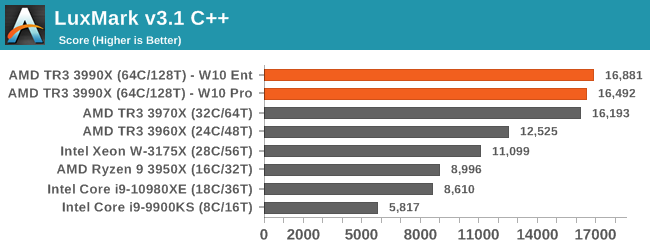
Luxmark is an AVX2 accelerated program, and having more cores here helps. But we see little gain from 32C to 64C.
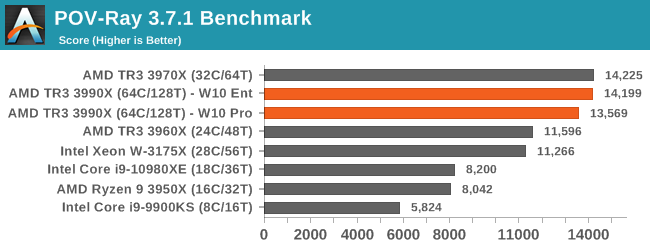
As we saw on the last page, POV-Ray preferred having SMT off for the 3990X, otherwise there's no benefit over the 32-core CPU.
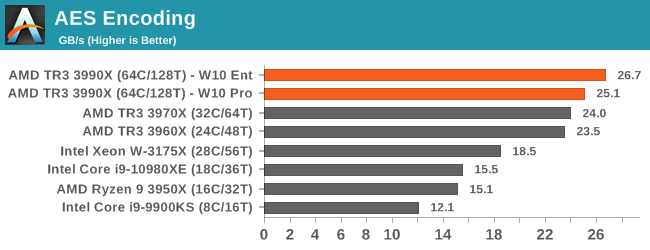
AES gets a slight bump over the 32 core, however not as much as the 2x price difference would have you believe.
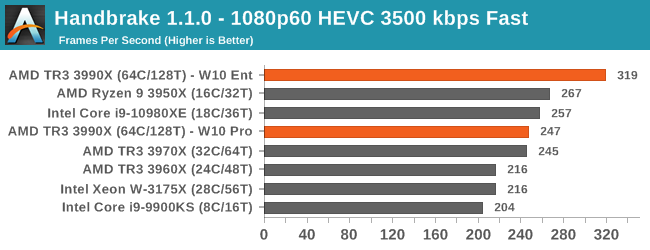
As we saw on the previous page, W10 Enterprise causes our Handbrake test to go way up, but on W10 Pro then the 3990X loses ground to the 3950X.
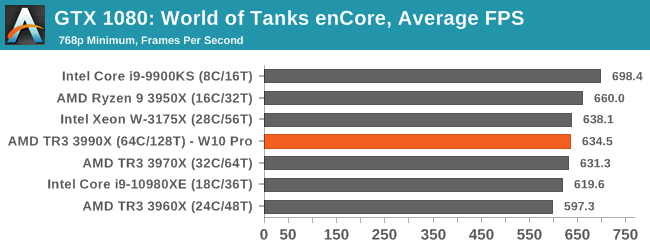
And how about a simple game test - we know 64 cores is overkill for games, so here's a CPU bount test. There's not a lot in it between the 3990X and the 3970X, but Intel's high frequency CPUs are the best here.
Verdict
There are a lot of situations where the jump from AMD's 32-core $1999 CPU, the 3970X, up to the 64-core $3990 CPU only gives the smallest tangible gain. That doesn't bode well. The benchmarks that do get the biggest gains however can get near perfect scaling, making the 3990X a fantastic upgrade. However those tests are few and far between. If these were the options, the smart money is on the 3970X, unless you can be absolutely clear that the software you run can benefit from the extra cores.










279 Comments
View All Comments
velanapontinha - Friday, February 7, 2020 - link
far too many to mention in a commentandrewaggb - Friday, February 7, 2020 - link
We use both. Windows server is fine. Very long support, much longer than Ubuntu lts, and it's stable.reuthermonkey1 - Friday, February 7, 2020 - link
I'm a Linux dude through and through, but most companies I've worked for use a lot of Windows for their backend systems. I think it's a bad idea, since dealing with Windows Server adds quite a bit to overall costs and complexity, but the financial folks demand it so they pay for it.FunBunny2 - Friday, February 7, 2020 - link
"the financial folks demand it so they pay for it."because they've been slaves to Office for decades. no other reason.
Ratman6161 - Friday, February 7, 2020 - link
There is cost and then there is cost. What does that mean? Well, I'm in a highly regulated environment where if an auditor saw a system that wasn't under manufacturers support, that's an automatic fail. So lets all please get the word "free" out of our vocabulary for this discussion. Linux is definitely not free. The companies that supply Linux distros just bill you for it using a very different licensing model than Microsoft does. To find the real costs, you have to figure the total cost of a system including all hardware and software and all costs associated with each. When you do that, a couple of things become obvious. 1) The cost of hardware is relatively trivial when compared with software licensing. 2) the cost of the operating system, regardless of what that OS is, is also relatively trivial though generally speaking we find that fully supported Linux and Windows end up costing very close to the same. 3) The big costs are for the software that runs on top of the hardware and OS. So saving costs by using Linux is essentially a fantasy.RRINKER also had a great point...the vast majority of Windows servers these days are virtual. We tend to have large numbers of small Windows servers dedicated to a particular task. We don't really find this adding complexity.
Whiteknight2020 - Friday, February 7, 2020 - link
Windows server is way cheaper to administer, configuration with group policy, DSC etc is way easier than messing with ansible, puppet etc. TCO is lower as windows admins are cheaper, SA licensing is on par or cheaper than RHEL/Oracle UK, server core is rock solid. I use & deploy both Linux & Windows, whichever the application runs best or more stable on.dysonlu - Friday, February 7, 2020 - link
It's cheaper the same way it is cheaper to outsource. The cost is hidden and usually comes later.PeachNCream - Monday, February 10, 2020 - link
This is the best approach. The underlying OS should be whatever is best suited to the task it is expected to perform within the limits of the costs running it incurs. Of course, figuring out what might be the best balance between costs and performance can be tricky and a lot of companies do not dedicate the resources to examine options, simply defaulting to something familiar while assuming it is the best choice..dysonlu - Friday, February 7, 2020 - link
Enterprise use Windows because they are pretty tech-illiterate and needs Microsoft support. Nobody will get fired for selecting Microsoft and Windows, even if it'll cost more and your whole IT will be at the mercy of Microsoft.But, kickbacks help a lot in the decision making.
zmatt - Friday, February 7, 2020 - link
Many. I would argue most actually. There are certainly some areas where Linux really shines but one place where they aren't just behind but completely non existing is competing with active directory. Most offices still use AD domains, and for good reasons, and Linux doesn't have an answer to it.We have a few VM clusters that run redundant DCs. Its the only option because active directory is unique. It isn't perfect, but nobody offers a competing solution. Someone could develop an open source competitor but nobody has.